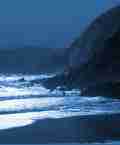 |
Search the site:

Walking Ireland’s MountainsThe South-EastThere was one particularly fine view over the inset Loch Muskry (a classic armchair corrie complete with water cushion) along to the cone of Galtymore. O'Loughman's Castle was very clear: a squat, square, crenellated tower until it is approached off Greenane when it disintegrates, as if by magic, into a crumbly conglomerate outcrop. It must be a place of legends. The small mountain ranges of the South-East are with one exception composed of either old red sandstone or Silurian rock. They are somewhat subdued in form but nonetheless surprisingly high, and boast one of Ireland's few Munros (peaks over 914 metres/3,000 feet high). Unusually for-Ireland, all the ranges are outside the ambience of the sea: they mostly rise from rich, well-populated, cultivated land and wide, coniferous plantations. One other general point: the Galtees, Knockmealdowns and the Comeraghs are quite close to each other, none too demanding and have plenty of varied accommodation around them. The Knockmealdowns (routes 4, 5) are similar to the Galtees; they consist of a simple east-west ridge about twenty-five kilometres/fifteen miles long with the northern slopes considerably steeper than the southern. However, they are less dramatic than the Galtees; there is but one corrie lake and no well-formed corries The highest peak, also called Knockmealdown, at 795 metres/2,609 feet is 120 metres/400 feet lower than Galtymore and lies in the generally higher and more rugged eastern section of the range. The northern slopes in particular are highly afforested, so access is restricted in many places, with problems made worse by the out-of-date depiction of minor roads on the maps. Three motorable north-south roads, one of which is the well-surfaced scenic Vee Road [R668] cross the range. They provide an excellent means of access but mostly only for there-and-back walks, unless a second car is parked at the top of a neighbouring pass to allow an A to B walk. The Comeraghs (routes 6, 7, 11, 12) and their southward extension, the Monavullaghs, extend south from the town of Clonmel in a zigzag fashion. The range is easily accessible from the west on a road which continues as a bridle path through the range. North of the path a long, narrow ridge with bold conglomerate tors extends to the very north of the range, in which the highest peak is Knockanaffrin (755 metres/2,478 feet). South of the path, peaks barely rise from a wet peat-hagged plateau, but this central section (central, that is, if the Monavullaghs are considered part of the range) is almost ringed by a set of fine carries containing beautiful lakes. One of these, the easily accessible Coumshingaun, is generally considered the finest corrie in the country. Just behind the corrie is the highest peak in the range, the nondescript Fauscoum (792 metres/2,597 feet), which barely rises above the general level of the plateau. A marathon walk, the “Comeragh Bog Trot” (mercifully it does not quite live up to its name) is organised for April of every year. The Monavullaghs are at the southern end of the Comeragh chain. Though they are considered drier and less boggy than the rest of the range, this does not fully compensate for the absence of the corries which are the prime attraction of the more northerly part of the range. The Comeraghs (including the Monavullaghs) are mapped at 1:50,000, a distinction in a region that is generally poorly mapped. Geologically a part of the granite Leinster Chain, the Blackstairs (routes 8, 13) are shaped like a rough F, their main ridge extending north-south, high in the north at mast-topped Mount Leinster (796 metres/2,610 feet) and petering out in the south. The range is composed of heathery, gently sloped mountains, nowhere more than one mountain wide. There are no cliffs, corries or mountain lakes. A road crosses the range at Sculloge Gap south of Mount Leinster, and the area south of this, a grassy ridge with some fine tors, is the most scenic and commands long views. A comparatively easy marathon walk is organised in May every year along the main chain of the Blackstairs.
|
[ Back to Top ]
All Material © 1999-2004 Irelandseye.com and contributors
